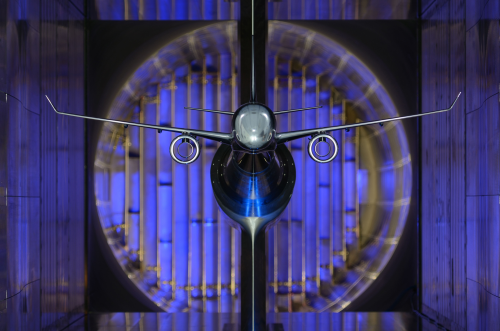
The CSeries aircraft is optimised for the growing 100- to 149-seat market and features a 46% composite structure. It is scheduled to enter service in 2013.
The wind tunnel test programme was Initiated more than 5 years ago, during the early stages of the CSeries’ conceptual design, and progressed through the aircraft’s subsequent definition and detailed design phases.
Bombardier reports that validation of the CSeries’ aerodynamic design included extensive use of state-of-the-art computational fluid dynamics (CFD), made possible through the use of contemporary super-computers significantly more capable, and 100 000 times faster, than computers available when the aircraft currently serving the 100- to 149-seat market were designed. These tools permitted the minimisation of interference drag and also facilitated the design of the engine nacelle and thrust reverser.
To simulate actual flying conditions, the wind tunnel tests were conducted with over 20 sophisticated scale models over more than 4500 testing hours at facilities in Canada, France, Germany, the Netherlands, the UK and the USA.
The scale models of the CSeries jetliner used in the testing were equipped with instrumentation to measure air flow, including as many as 700 pressure-sensitive ports over the wings, fuselage and tail. The models included moving parts, such as wing flaps and leading edge slats, which could be repositioned to reflect actual flying events. Some models were equipped with miniature air-driven turbine engines to gauge the air flow interference with the aircraft wings. The largest of the models, at 13.7%, had a wingspan of approximately 4.5 m (15 ft).
Using the scale models and the environmental conditions possible in the wind tunnels, Bombardier engineers were able to simulate the aerodynamics of the CSeries aircraft in various flight scenarios such as landing, take-off and cruising at high altitudes.
“Simulated conditions during the wind tunnel tests closely correlate to real world flying conditions and the resulting data were used to improve and validate final CSeries aircraft design and systems,” says David Tidd, Vice President, CSeries Integrated Product Development, Bombardier Commercial Aircraft. “This latest achievement for the CSeries aircraft represents the most extensive and complex wind tunnel testing that Bombardier has ever conducted; it marks another key advance in the jetliner’s development.”
Bombardier currently has firm orders for a total of 133 CSeries aircraft, plus options and purchase rights for an additional 129 aircraft.






